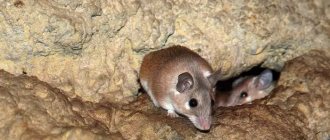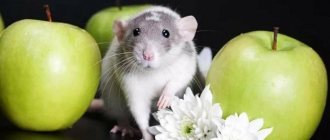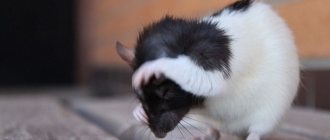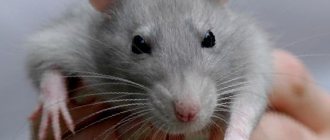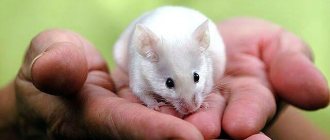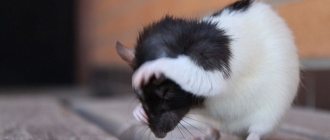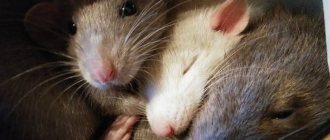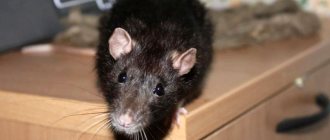- Wild animals
- >>
- Mammals
The Gambian rat is one of the largest species in the rodent family, but also one of the friendliest. Due to the large size of Gambian rats, they pose a serious threat to native species (especially nesting species) and crops, especially if they invade mainland Florida.
Origin of the species and description
Photo: Gambian rat
Gambian rats are found in central Africa, in areas south of the Sahara Desert and as far south as Zululand. This includes countries like Nigeria and others.
Gambian rats are burrowing animals. They prefer cool, dry and dark places to place their burrows as they are sensitive to heat. In their native range in Nigeria, Gambian rats are found in degraded forests, forest clearings and edges, coastal areas and sometimes near human habitations. Burrows are built near the roots of large trees, especially oil palms and the stumps of dead trees. They also inhabit areas near termite mounds, probably because these areas remain dry and cool during the rainy season.
Video: Gambian rat
This species is very common in the natural habitat of the Grassy Key area. They do not appear to live in wet scrubland or mangrove areas. They have also been reported in modified and developed residential areas. They may not need to create their own burrows in the Florida Keys, since limestone formations, trees, human habitations and trash piles are good substitutes.
The Gambian rat, also called the African giant rat, is one of the largest rats in the mouse family with an average length of about 1 m, including the tail. The Gambian rat can weigh up to 4 kg, which is comparable to a small domestic cat.
Habitats and behavior in natural conditions
The habitat of wild Gambian rats covers the territory of the central part of the African continent - from the southern outskirts of the Sahara to Zululand. In their natural environment, animals live in groups of up to 20 individuals. They live in a variety of natural areas:
- arid;
- savannahs;
- with a temperate climate;
- forest;
- mountain (can climb to a height of up to 3500 m).
The animals avoid open spaces. For housing they usually choose:
- burrows;
- rock crevices;
- tree hollows;
- and other secluded corners.
Sometimes Gambian rats settle in cities, villages and other areas inhabited by people. Such a neighborhood does not bring anything good to a person - the animals manifest themselves as pests and cause significant damage to the farm. The dirty tricks of rats include:
- eating human supplies stored in cellars, barns, etc.;
- damage to property;
- destruction of plantings and crops;
- sewer blockage;
- destruction of soil structure;
- causing drying out of the nutrient soil layer.
The last two points are related to the fact that the animals create an extensive complex of tunnels in the ground for safe and secret movement.
Rats are nocturnal. Only in the dark do they leave their shelters and go in search of food.
The animals stop encroachments on their territory, protecting their homes. But they rarely bite - only during intra-family conflicts or when they are very frightened. Gambian rats never attack first.
Appearance and features
Photo: What a Gambian rat looks like
Gambian rats are large rodents native to Africa. They are wild animals that can grow to the size of a small dog. Gambian rats do not make good pets, but some people still keep them in their homes.
Gambian rats are similar in size to other species of African giant rats and are often confused with this species. Gambian rats have coarse brown fur and a dark ring around the eyes, unlike African rats, which have a soft gray coat with white fur on the belly. Their long tails are scaly and they have narrow heads with small eyes. Unlike other rats, Gambian rats have cheek pouches.
Fun Fact: The main physical characteristic of Gambian rats is their large cheek pouches. These pouches can expand to enormous sizes, allowing Gambian rats to transport huge amounts of food when needed.
In captivity, these rats begin to exhibit color variations. These changes include very fine stripes and spots on the shoulders and hips, small white markings on the head such as a dot between the eyes or flames, and changes towards completely black are also found. Their most distinctive feature, common to both domestic and wild species, is their two-colored tail. Approximately two-thirds of the tail is dark, and the last third is very pale or white.
Females and males are generally the same size, with little sexual dimorphism. Gambian rats can reach sizes of up to 910 mm or more, including the tail. These rats also have a very low fat content, which may be why they are prone to catching colds. A distinctive feature of the Gambian rat is its hairless tail, which makes up almost half of the animal's total length. As a nocturnal animal, the Gambian rat has poor vision, but has an acute sense of smell and hearing.
Captivity
In Africa, marsupial rats are used as bloodhounds. Thanks to a well-developed sense of smell, animals are able to recognize mines. Rodents can smell contraband. For example, smelling drugs in bags of coffee. They are also used instead of dogs for military reconnaissance. It takes 7 months and more than 5,000 euros to train one animal.
This is interesting! Gambian rats help fight poachers in Africa. With the help of animals, tusks and scales of lizards are found, which are exported from the continent to Asia.
But mammals are suitable for more than just official duties. They are friendly and approachable. Rats love affectionate treatment. Rodents become attached to their owners and can be obedient pets.
Selection and preparation of a site
Rats, accustomed to the African climate, need a constant source of heat. In the room where the pet will be kept, the air must be heated to 20°C. It is advisable to avoid any temperature changes.
Special requirements also apply to lighting. Nocturnal animals are accustomed to soft, dim light. The sun's rays should not penetrate into the room where the animal is kept.
Cage requirements
An adult requires a spacious enclosure. The rods must be made of thick metal. The animal will bite through a thin aluminum wire in a few minutes. Cages made of plastic or wood are not suitable as they will not hold the animal.
The bottom of the enclosure must be covered with a special composition that imitates natural soil. The following fillers are suitable for this:
- dry grass;
- granulated wood shavings;
- sawdust.
The Gambia loves to hide, so the enclosure must be equipped with places where the animal will feel safe. Small houses, hanging hammocks, and grass mounds are suitable. The animal will also enjoy the labyrinth through which it can navigate inside the enclosure.
Nutrition
The pet must be fed at least twice a day. Portions must be fixed. It may seem that the Gambian rat will never get enough food, no matter how much food is offered to it. But this is a lie. The animal places food behind its cheeks and hides it in secluded places. If your pet is overfed, it may develop health problems. Despite their large size, Gambians are quite thin animals.
The rat should always have access to fresh water. The animal's diet should be made as varied as possible.
Vegetables
Fresh vegetables and herbs must be included in the menu of a pet rat. You can give this food once a day. The rats' favorite treat is sweet potatoes. It is better to give it boiled. Also, rats will not refuse other vegetables, such as carrots, zucchini, beets and cucumber. The dosage is calculated individually. If your pet has loose stools after eating vegetables, you need to reduce the daily portion. Radishes and turnips are not suitable for feeding.
Fruits
Rodents love sweet food. They feed on fruits such as apples, peaches, apricots, and watermelons. A rat will never refuse a banana. Fruits can be given every other day. If the animal begins to gain weight, the amount of fruit in the diet should be reduced. It is not advisable to include citrus fruits in the rat's menu. They can cause allergies in the animal.
Legumes
Beans, soybeans and beans cause increased gas production in rodents, causing them discomfort.
Dried peas and chickpeas can be added to food in small quantities. But only if the animal does not have digestive problems.
Seeds
Grains are the basis of rat nutrition. They should make up at least 50% of the daily diet. Food can be purchased at a pet store. The price of the mixture differs depending on the composition. It is better to choose food with minimal additives. While the bowl of ordinary ornamental rats should always be full, this is not suitable for Gambias. They need to dose their portions.
Lean boiled meat
Rats eat not only plant foods, but also animal protein. You need to give meat to the animal no more than twice a week. The amount of protein can be increased for a young individual. The meat must be boiled before serving. You can replace it with baby food or food for dogs and cats.
Low-fat cottage cheese
It is advisable to give fermented milk products to African rats several times a month. They are a source of calcium for the body. You should choose cottage cheese with a low fat content.
Some mammals of this species are lactose intolerant. In this case, you need to abandon cottage cheese in favor of dairy products without this component.
Boiled eggs
Eggs are a source of animal protein. They can be given several times a week. Both chicken and quail eggs are suitable.
Seafood
Meat and eggs in the weekly diet of the marsupial hamster rat can be replaced with boiled fish. Any variety will do. You can also use other seafood. But they also need to be boiled first.
Animal care
African rats, like all rodents, are easy to care for. It is necessary to clean the cage on time and provide the animal with constant access to water.
We must not forget that initially the giant rat was a wild steppe animal. She needs constant movement. The pet should be walked every day, providing sufficient space.
Leftover meat and fruit spoil quickly. After a day, they need to be taken out of the pet’s enclosure so that the animal does not get sick.
Character and education
Gambias are affectionate and gentle animals. They quickly get used to hands and need constant tactile contact. Their character is very calm. A rat will not bite unless it is scared.
Animals have well-developed intelligence. The rodent can be trained and taught interesting tricks.
Neighborhood of male and female
Having acquired several pets, you must take into account that they will have to be kept separately from each other. Several individuals may fight and bite.
Females and males live together only when the female is raising her male offspring. In such a situation, it is undesirable to separate the rat pups from their mother for a month. The adult male must live separately from the female and cubs, as he eats his offspring.
Where does the Gambian rat live?
Photo: Gambian hamster rat
Gambian rats can be found in a variety of habitats near man-made objects or in the forest. Their hiding places are underground and usually in the most shaded areas to keep the burrow cool and protected. As an omnivore, the Gambian rat can survive on a variety of foods, allowing it to breed in a variety of habitats where small invertebrates or vegetation are present.
Interesting fact: On its native African continent, the Gambian rat is used to detect underground mines.
Providing a good, strong, large cage for your rat at home can be challenging. It's also worth remembering that even with a large cage, rats will need to leave the cage daily to socialize and move around. These rats can start chewing everything they see around them, so be sure to keep a close eye on them when they are outside the cage. The basic requirements for the cage are minimal: the more space the Gambian rat has, the better.
Fun fact: Gambian rats live for about 5-7 years in captivity, although some have been known to live up to 8 years. The lifespan of these rats in the wild is difficult to document due to the creatures' small size and because they are so often hunted by indigenous peoples.
Now you know where Gambian rats live. Let's see what to feed them.
Top biggest rats in the world
3062
21
2020, according to the Eastern horoscope, will pass under the sign of the White Metal Rat. According to an old legend, the rat showed cunning and climbed on top of the bull. And now, the year of the rat is followed by the year of the bull, and not vice versa, as it could have been before.
Giant rats and mutant rats are, of course, fiction. In nature, such representatives of this animal species do not exist. However, some breeds reach such a size that they can be walked on a leash and are larger than an average-sized cat and some dogs.
There are no giant rats in Russia. The largest rodent is the common large gray rat. It reaches 40 centimeters in length. Found in coastal reservoirs, rivers and lakes.
But the woolly Bosavi lives in New Guinea. This rodent can grow up to one meter
in length, and its weight is up to 15 kilograms. Thus its size is comparable to that of a dog. Moreover, they are not afraid of people, they allow themselves to be stroked and do not bite. This is mainly due to the fact that they live far from civilization and from people, so they simply do not know that people can be dangerous to them. Bosavi were discovered relatively recently. Until now, they have not been given a scientific name.
Bosavi is considered the largest rat on our planet and is listed in the Guinness Book of Records.
Behind it in size is a reed rat. Its dimensions are slightly smaller - 6-10 kilograms and about 80 centimeters. She lives in Africa. It is noteworthy that these rodents are bred in many African countries on farms and household plots in order to obtain dietary meat. It tastes like nutria meat, it is high in protein and low in fat. In a number of regions, the rodent is considered a harmful pest. He loves to visit plantations and feast on the juicy shoots of sugar cane and grain crops.
Bamboo rats are also considered giants. They live in Asian countries. They reach no more than 50 centimeters in length. Reeds are not simple rodents, but burrowers. They have small eyes and small ears. At the same time, they have large, long claws with which they dig the ground.
Another giant is the kangaroo rat. These are nocturnal animals. The main habitat is dense bushes, steppes or undergrowth. Kangaroo rats have short legs and long hind legs designed for jumping (like kangaroos, which is how they get their name). They can jump up to three meters in one jump. The long tail is used for balance.
What does the Gambian rat eat?
Photo: Gambian pouched rat
The Gambian rat is a large, invasive animal that poses the greatest threat to crops and small native species found within Florida's borders. Many endangered species are most at risk from the Gambian rat due to its ability to compete for resources combined with high fecundity.
The Gambian rat differs from other rodents in its ability to store grain and food in its cheek pouches. This allows for more food to be consumed at one time and increases the likelihood of crop damage.
Gambian rats are omnivores and are known to consume:
- vegetables;
- insects;
- crabs;
- snails;
- palm kernels and palm fruits.
If you keep Gambian rats at home, remember that they need more protein than their smaller brothers. They are omnivores in the wild, feeding on everything from plant matter to insects and some small mammals. Animals kept as pets eat a variety of vegetables, fruits, nuts, seeds, grains and meats, as well as eggs. A specialist should be consulted about the appropriate diet for a particular animal. Rodents also like to dig into the bedding at the bottom of the cage and store food there.
Rat diet and nutritional nuances
Gambian rats are omnivores. But foods from the human table (salted, spicy, fried, etc.) are prohibited for the animal. The same applies to drinks - you can only drink water. The basis of the rat's menu should consist of the following:
- vegetables;
- fruit;
- seeds;
- nuts;
- legumes
The most important substance for the rat body is protein. Its share in nutrition is 40%. In nature, rats get their protein from insects and shellfish. To obtain protein, a pet needs to consume:
- seafood;
- boiled lean meat;
- boiled eggs;
- low-fat cottage cheese.
You need to feed your pet twice a day. The size of portions must be controlled - the animal will not refuse additional treats, but this will negatively affect its health. Therefore, it is important to ensure that your pet does not overeat.
The animal must have constant access to food and water, so food and drinking bowls must be replenished on time. If the feeder empties too quickly, you should not increase the portions for a supposedly hungry pet. The hamster rat has the habit of storing food supplies, i.e. hide food in various hiding places.
Features of character and lifestyle
Photo: African Gambian rat
Gambian rats are nocturnal animals, mainly because they have little or no tolerance for the intense heat of a typical African day. They are almost inactive during the day and come out at night in search of food. Gambian rats often use an extensive system of tunnels or hollow trees for their nests, where they rest during the day and emerge at night to search for food. These nests are often located in cool areas, providing more evidence of their heat intolerance.
Interestingly, Gambian rats find almost as much value in the act of carrying as they do in storing food. This results in intricate hoarding patterns where food is abundant at all times of the year. The pouches inside the cheeks of Gambian rats can hold more than 100 ml when filled, and this allows them to transport huge amounts of food in a short period of time. Some studies have shown that Gambian rats transport 3 kg in two and a half hours.
Gambian rats are also very good climbers and swimmers and can easily travel 2 meters. Both sexes are very territorial. Although Gambian rats tend to be solitary in the wild, females often form large groups containing many mothers and their litters, while males tend to remain solitary. These rats quickly adapt to new situations, such as captivity. Gambian rats are also known to huddle together when the temperature drops. Due to their low fat content, they do not retain heat easily.
Because Gambian rats are new to captivity, in a home environment they can be a little more unpredictable than other rats, and their temperament can vary from individual to individual. Although they can often be kept as pets, some Gambian rats remain shy or become aggressive over time. However, they can be trained, after which most rats become friendly and easy to handle.
Damage from giant rats
The Gambian hamster marsupial rat can cause great harm to humans. The animal is a carrier of monkeypox. This is a rare infection that results in body rashes and fever.
In addition, rats cause a lot of damage to property and products.
Destruction of food supplies
Gambian rodents are omnivores. They feed on a variety of fruits, nuts and seeds. Thanks to their developed sense of smell, animals easily find food. They sneak into barns and basements to eat supplies.
Damage to property
Rodents love dark, warm rooms. In cities, they choose sheds, barns and haylofts for settlement. In homes, rats live in attics and basements. Animals are always close to a food source. They choose places with stored supplies to live. For example, storage rooms. To get to food, animals gnaw their way through.
Sewer blockage
Rats can live in sewer mines. They are not afraid of moisture, and also prefer dark rooms. The sewage system is completely suitable for the comfortable existence of rodents. Animals get into them through hatches or rotten sections of pipes.
Animals use sewers to move around. They are able not only to climb horizontal surfaces, but also to climb vertical structures. Due to their large size, giant rats often get stuck in pipes, causing clogs.
The sharp teeth of rodents easily destroy any surface. They chew through plastic, corrugation, and cast iron. Thus, the sewer system is severely damaged.
Destruction of soil structure
The main place for African marsupial rats to spend the night is in earthen burrows. Animals dig passages with their paws, damaging the soil. Loosened soil dries out quickly. Because of this, plants die.
Rodents also pose a danger to ancient trees. By digging holes, they damage the root system. The trees gradually weaken and dry out. Young shoots can die completely within a few days.
Destruction of crops
One colony of African rats carries more than 20 kg of food within an hour. In agricultural areas, rodents feed on grains. They destroy huge areas of crops. In some cities, rat infestations have caused so much damage to crops that authorities have banned the import of animals. For example, in the American islands of the Florida Keys, gambia cannot be transported since 2003.
Social structure and reproduction
Photo: Baby Gambian rat
Mating in Gambian rats involves the formation of a social pair bond between one male and one female. The male usually sniffs or licks the female's urogenital areas before attempting to mate with her. Gambian rats also exhibit distinctive courtship behavior. The male and female will often stand upright and scratch each other, then chase each other until the female is ready to copulate. If the female is not receptive or rejects the male, she will bite his tail before courtship behavior begins.
Gambian rats usually breed in the summer. The estrous cycle lasts from 3 to 15 days. Interestingly, the estrous cycle is often irregular and seems to be influenced by many external factors, including the environment. Other factors include the presence of males and captivity. Females reach sexual maturity in about 6 months and typically have about 9 litters per year. The gestation period is approximately 30 to 32 days. Females are also very aggressive when giving birth to their young.
Young Gambian rats are born hairless, with their eyes and ears closed. The characteristic long tail does not show significant growth until about 30-35 days. The eyes do not open until about 21 days of development, although the young are fully furred and have open ears after about 14 days.
The female provides the most parental care, both as a source of warmth for the naked young and as a source of milk. The female also changes her eating habits before the cubs are weaned, choosing softer foods. The male, on the other hand, takes little care of the children. It is tolerant at best, and sometimes kills young individuals and eats them. This is not as common in females.
Description of appearance
By rodent standards, it has impressive dimensions:
- The body length of an adult rat reaches 90 cm along with a tail about 40-45 cm long;
- body weight ranges from 1 to 1.5 kg.
If you do not take into account the large size (the Gambian rat is one of the largest species of mouse-like animals), in appearance the animal is similar to its rat relatives. The coat is rough. The main color is brown or gray (shades may vary). The fur on the back is always darker than on the belly.
Dark circles frame the eyes. The ears are large, oval, and open. The tail is covered with scales and hairs. The appearance of males and females is no different.
Natural enemies of Gambian rats
Photo: What a Gambian rat looks like
There are no real predators that target Gambian rats in the wild. Although there have been a few recorded cases of a bird of prey or other predator eating Gambian rats, they usually gang up and are formidable opponents to potential predators. The biggest predator of Gambian rats is humans, the indigenous African population. These rats are considered a delicacy and are often hunted for food. They are considered quite tasty and are hunted and even farmed for their meat, which has led to a significant decline in the population.
Interesting Fact: Gambian rats are often used for experiments in the scientific community and provide a wealth of information about rodent physiology and behavior.
Gambian rats serve to control insect populations, but they also carry seeds of various plants when they eat the resulting fruits. Several parasitic worms live in the gastrointestinal tract of these rats, but the most common one is Strongyloides.
The study also showed an insignificant presence of tapeworms among other parasites. Other parasites include:
- xenopsylla cheopis;
- aspicularis tetraptera;
- ixodes rasus;
- ornithonyssus bacoti.
Hymenolepis is usually found in the rat's small intestine, while Aspicularis is found in the rectum and colon.
More about huge mutant rats
Yet stories of giant mutant rats in the Moscow metro or abandoned military bunkers remain surprisingly enduring. Their phenomenon is easy to explain: people do not want to put up with the dullness of their everyday lives and are willing to believe in almost any unusual and inexplicable phenomena, even frightening ones. After all, these “horror stories” give hope that the world around is not as ordinary and dull as it seems most of the time, and there is certainly a place in it for some mysteries - including mutant rats.
Simply put, people want to believe in the existence of monster rats, and science fiction writers, horror film directors, and rumor mongers simply exploit these fears to their advantage. As a result, more and more new versions of “facts” and “eyewitness accounts” constantly appear, and the old ones are repeatedly altered and turned into more and more new versions, sometimes completely different from the originals.
For example, the stories allegedly told by Moscow metro drivers are very well known. According to them, in the farthest sections of the tunnels, the headlights of trains occasionally reveal huge rats the size of dogs crossing the tracks. Most of these stories are full of chilling details: in that brief moment that a ray of light snatches a rat from the darkness of the tunnel, the animal manages to look at the driver with evil green (in other versions - red) eyes, and then suddenly news appears that these animals no poison works. It is unknown which of the drivers tried to poison these mutants (just as the names of those who actually saw these animals are not known), but most storytellers consider it their duty to mention such immunity.
Also popular is an allegedly real story that happened to a group of Moscow diggers (specialists involved in the study of caves and artificial underground tunnels). In a sewer under the zoo, this team was attacked by five large rats the size of a dog, and the guys were saved only by throwing their crowbars at the animals and in this way scared them away.
This story was continued. They say that an anonymous person later called the diggers club and said that there were a lot of large rats in secret bunkers for storing radioactive waste. It is well known that the more secrecy and conspiracy theories there are in a story, the more popularity it will have...
There are also stories circulating among people about giant rats climbing out of manholes near landfills and scattering dogs there. Moreover, these stories are unusually tenacious: the first reports of such rats appeared back in 1989, and after that their number has only increased.
It is interesting to note that the less believable each particular story is, the more easily it spreads among the people. It is the details that seem fantastic that make such tales “hot”: either huge rats create the most complex organizations with commanders, pioneers and suicide bombers, or they deliberately feed on poisons or winding wires - there are countless such details.
Someone is even trying to mix together rumors about mutant rats and news about the discovery of Bosavi woolly rats. The result is a mix unimaginable for a specialist that, they say, scientists have discovered a new species of giant rats - Indonesian - in the Moscow subway. Why Indonesian? Simply because the name is simpler than “Bosavi woolly rat” or “Papua New Guinea rat.”
We will not waste time refuting such speculation, but will only say that none of these rumors have factual confirmation.
Habitat
Gumby rats live on the African mainland. They can be found in different parts of the continent, from the Sahara Desert to the “Land of the Zulu”. They live in different areas. Rats are found in arid desert areas. A colony of rodents can move across the African savanna. But most of all, mammals prefer forest areas with a moderate, cool climate.
African rats constantly hide from other animals. They settle in earthen burrows and tree hollows. In mountainous areas, mammals choose rock crevices as shelter. Some groups of individuals live in populated areas, hiding in basements and burrows.
Giant rats don't travel alone. They settle in a group of individuals. The number of one colony can reach 20 mammals.
Types of dumbo rats
Among the diversity of species, everyone will find a companion to suit their taste. All animals are interesting in their own way.
Dumbo rex. A distinctive feature of the species is the curly fur. From a distance, the lop-eared rodent resembles a fluffy toy. The animal's curled antennae create a funny look. If you take the animal in your hands, you can see thick and wavy fur, hard to the touch.
Dumbo rex rats come in different colors: tri-color, white, gray, black.
Dumbo sphinx. A win-win option for pet owners with allergies. Rats have no hair. Bare folded skin evokes tenderness and tenderness in the soul towards defenseless animals.
Sometimes sparse hairs are observed on the head, back, and paws. Skin color can be black, white, pinkish, bluish, even chocolate. It is pleasant and silky to the touch. The antennae are small and slightly curled. The appearance of hairless rat pups is associated with the action of mutated genes.
Dumbo Siamese rats. The self-explanatory name reflects the color feature characteristic of Siamese cats. The tail, paws, and muzzle, painted in dark tones, contrast with the whitish coat on the rodent’s body.
The offspring of Siamese rat pups may not get the same colors. Unlike other species, the nature of the animals is capricious with aggressive manifestations. It is not recommended to have a pet for small children.
Dumbo Husky. A rare breed of rodents, also called chameleons. The name is borrowed from a famous dog breed. It is noteworthy that babies of this species are born in the usual colors: white-gray, brown, black. Over time, growing pups change their fur coat to a new one, diluted with snow-white touches.
Manx. A species of tailless animals obtained as a result of gene mutation. When purchasing this species, you can be deceived by dishonest sellers who offer ordinary animals with docked tails after birth.
Blue mink. A rare breed that is difficult to find. The name conveys the characteristic color of a delicate blue hue.
The color and structure of the fur of rats of the same species may vary. The fur is often straight and velvety, less often curly or satin, when only the muzzle is covered with long hairs. In addition to traditional colors (gray, brown, black), there are rare animal colors - mosaic, topaz, amber.
Large species of rats in the wild
Some species of rats living in the wild cause harm to people, their homes and crops. However, most breeds are not dangerous and do not deserve pest status or harsh treatment.
Nezomyidae
Nezomyids are a whole order that includes rodents of various sizes and breeds. The family is distributed on the island of Madagascar and southern Africa. Rodents have short hair, brown or black. They are able to quickly move through trees and bushes in search of food. Animals are omnivores, so in addition to plant foods and insects, rats feed on chicks and reptiles.
- The size of the rat is 40-65 cm, but the largest representative of the family has been recorded in history, the length of which reached half a meter;
- Weight varies from 5 to 8 kg.
- Life expectancy: 1-1.5 years.
Cane rat
Cane rats are considered the largest in the world. They are often confused with nutria due to their impressive size. The animal got its name from its habitat: areas with moist soil and reed thickets. Unfortunately, in West Africa, people treat rats as pests and often kill them or sell their meat for sale.
- Size 45-60 cm, short tail 25-30 cm;
- Weight reaches 9 kg, but young individuals weigh 5-7 kg;
- Average life expectancy is 2-4 years.
Bamboo rat
Bamboo rats are one of the largest representatives of the mouse family. Rodents live in Southeast Asia, mainly in Thailand and the Malay Peninsula. The rat got its name from its addiction to bamboo, which is considered the basis of its diet.
Size 45-50 cm, tail is almost three times shorter than the body - 15-20 cm.
Compared to other relatives, this type of rat is very calm and slow, spends most of its life in the hole and occasionally comes out at night to eat. In some regions, the animal is eaten.
Woolly rat
The woolly rat is a very rare species of rodent that was discovered in the volcanic crater of Mount Bosavi in New Guinea. The appearance of the rat is more reminiscent of a capybara, so the animal’s fur is silky, and its muzzle does not look like a typical rat’s.
- Size 70-80 cm;
- Weight reaches 1.4-1.6 kg.
The woolly rat is adapted to human society and allows people to pet and study it. No other habitat of the rodent was observed.
Gambian marsupial
The Gambian marsupial is perhaps the cutest of the large rats. It is also called “Khomyakova” because of its characteristic fur and body structure. The breed cannot boast of good eyesight, however, hearing and smell compensate for the congenital defect.
- Taking into account the tail, which occupies the entire body, the length of the rodent is 70-100 cm;
- The weight of an adult is 1-1.5 kg.
It lives in Africa, adapts both to hot deserts and savannas, and to tropical forests.
Turkestan rat
The Turkestan rat primarily lives in nut and fruit forests of Uzbekistan, Kyrgyzstan, Tajikistan and southern Kazakhstan. Quite a dense build, the appearance combines the characteristics of a pasyuk and a black rat.
- Body length 20-26 cm, tail on average equal to body length - 23-26 cm;
- Weight: females gain weight up to 200-250 g; males 350-400g. Some individuals reach 500-600 g.
Unlike its relatives, the Turkestan rat gets along well with people and often lives in outbuildings and basements.
Gray big rat (Pasyuk)
Pasyuk is a rat known all over the world. The animal is able to adapt to any conditions and environment. They live everywhere, not only inhabiting the cold continents of the Arctic and Antarctic. They move in packs; one group can include hundreds of individuals.
- Size 20-25 cm, tail length 18-25 cm;
- The color is gray, sometimes there are brown spots on certain parts of the body;
- Weight: minimum - 150 g; females - 250-300; males - 350-500. There are cases when pasyuk reached 900-1000 g.
Potoroo
Potoroos are a very unusual species of wild rat, if only because they belong to the order Kangarooidae. Habitat: Australia and Tasmania. They live in forests located 200 m above sea level.
- Size 30-40 cm, tail length 15-27 cm;
- Weight: 700 - 1800 g depending on the age of the rodent.
Animals move by jumping using their hind limbs. Mainly active at night and late in the day. They feed on plant products or small insects. There have been no recorded cases of attacks on humans.
Would you have a large rat in your home? Poll Options are limited because JavaScript is disabled in your browser.
Reproduction of animals
The breeding season for Gambian rats is summer. But when kept at home, this process can occur regardless of the season. The minimum age of potential parents is six months.
Mating is preceded by mating games. However, even at the initial stage of courtship, the female may reject her admirer. She expresses her refusal by biting the male on the tail or back.
Pregnancy lasts a month, in one litter there are from 1 to 5 rat pups. Newborn rat pups have no fur or tail, and their eyes and ears are closed. Their tail grows by the age of one month. The eyes open 3 weeks after birth, and the ears open 2 weeks later. The fur appears gradually.

